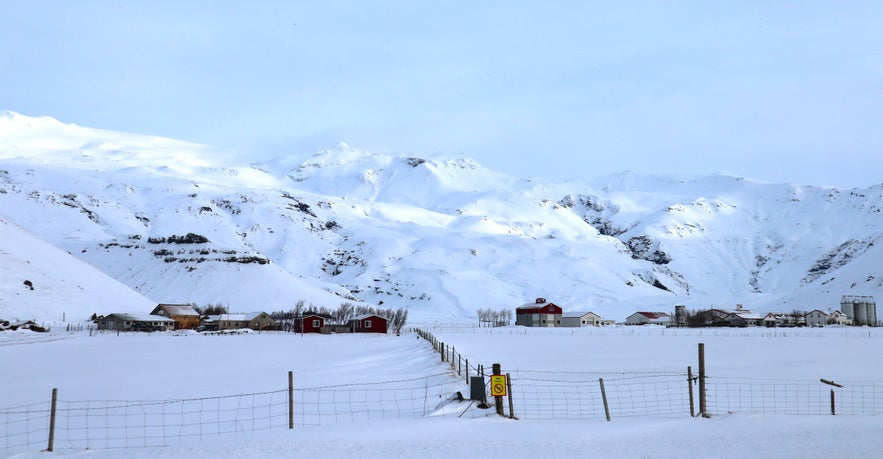Isbrevulkanen Eyjafjallajokull er beryktet over hele verden for å ha forårsaket kaos i flytrafikken i 2010, og for å ha gitt TV-reportere over hele verden problemer da de skulle uttale navnet. Den er 1651 meter høy og er et av de mest dominerende innslagene på sørkysten.
Eyjafjallajokull kan sees på mange turer på sørkysten. Denne 6-dagers feriepakken og denne 10-dagers bilturen er bare to eksempler på de mange turene som går forbi Eyjafjallajokull. Dersom du leier bil, kan du reise sørover for å se den på egen hånd.
Hvorfor du kan stole på innholdet vårt
Guide to Iceland er Islands mest brukte reiseplattform og hjelper millioner av besøkende hvert år. Tekstene våre er skrevet og sjekket av folk som bor her og kjenner landet ut og inn. Derfor kan du alltid regne med ærlige, oppdaterte og pålitelige reisetips.
Geografi
 Eyjafjallajokull er omtrent 100 kvadratkilometer stor, noe som gjør den til landets sjette største isbre. Den ligger like ved den fjerde største, Myrdalsjokull, som også skjuler en beryktet vulkan, nemlig Katla.
Eyjafjallajokull er omtrent 100 kvadratkilometer stor, noe som gjør den til landets sjette største isbre. Den ligger like ved den fjerde største, Myrdalsjokull, som også skjuler en beryktet vulkan, nemlig Katla.
Selv om utbruddet fra Eyjafjallajokull var enormt og ødeleggende, blekner det i forhold til potensialet til Katla. Den er langt mer eksplosiv og ligger under mye tykkere is, og et utbrudd her under ugunstige vindforhold kan få verdensomspennende konsekvenser.
Magmakamrene mellom disse to mektige vulkanene er forbundet med hverandre, og dessverre for oss følges et utbrudd ved Eyjafjallajokull som regel av et utbrudd ved Katla i løpet av et tiår.
Eyjafjallajokull har mange breutløp, og det mest kjente er Gigjokull. Mange elver renner ut fra smeltevannet, og en av disse faller ned i den vakre fossen Seljalandsfoss på sørkysten, som det er mulig å gå helt rundt.
Utbrudd
Eyjafjallajokulls siste utbrudd var uten tvil det mest berømte i Islands historie (selv om æren egentlig burde tilfalle Laki. Utbruddet fra Laki i 1783-1784 forårsaket en askesky så stor at Europa ble rammet av en hungersnød som mange historikere mener førte til den franske revolusjonen). Den 27. mars 2010 begynte magma å boble opp under overflaten, og den 14. april begynte aske å velle opp fra toppen.
800 mennesker ble evakuert, ikke av frykt for magma, men for de like farlige isbreflommene, som tidligere har ødelagt islandske byer. Dyr ble holdt inne, og de med luftveisproblemer fikk beskjed om at de også burde holde seg innendørs.
Flytrafikken over hele Europa ble stanset, da asken allerede om kvelden den 15. april var over Storbritannia, Skandinavia og deler av Tyskland. Feriereisende satt fanget i påvente av nyheter, og ble sittende fast i åtte dager; i Skottland og Irland ble til og med flyvninger forsinket i mai på grunn av ettervirkninger.
Heldigvis kom ingen mennesker til skade, selv om asken antas å ha forårsaket luftveisproblemer for noen sør i landet. Mange gårder ble også ødelagt av asken og oversvømmelsene, og noen bønder sliter fortsatt med å komme seg.
Siden Island ble bosatt i år 874, har den også hatt utbrudd i år 900, 1612 og fra 1821 til 1823. Sistnevnte utbrudd frigjorde enorme mengder fluor, noe som antas å ha påvirket beinhelsen til både mennesker og dyr på den tiden.
Eyjafjallajokull i dag
Eyjafjallajokull er nå helt trygg å besøke, og den kan sees på de fleste turer langs sørkysten i klart vær. I byen Hvolsvollur finnes det et besøkssenter om vulkanen, som fokuserer på opplevelsene til familien som eide gården Thorvaldseyri, som var en av de mange gårdene som ble ødelagt av oversvømmelser, lava og aske.
Det er svært lite sannsynlig at Eyjafjallajökull vil få utbrudd igjen med det første, med hundrevis av år mellom hvert utbrudd, men som nevnt kan det hende at naboen Katla begynner å buldre ...









